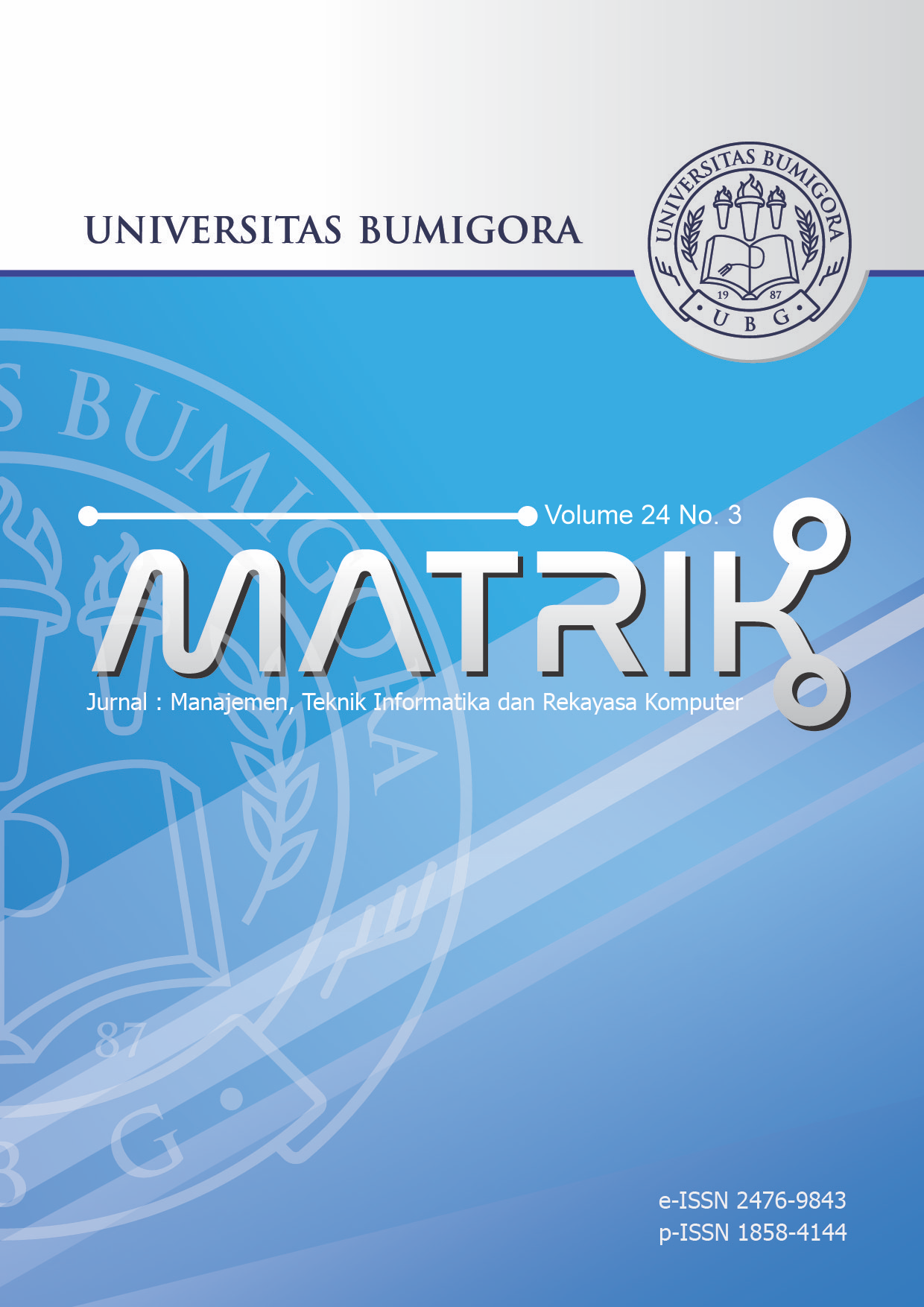Artificial Intelligence Enhanced Direct Current Fast ChargingIntegration for Electric Vehicles on 20 kV Grids: A Technical andOntological Study
DOI:
https://doi.org/10.30812/matrik.v24i3.4923Keywords:
Artificial intelligence, Electric vehicles, Ontology, SustainabilityAbstract
Ontological philosophy offers a conceptual foundation to reflect on the existence and evolution of electric vehicles (EVs) as intelligent energy entities. The transition to electric vehicles has attracted global attention, particularly regarding sustainability and energy efficiency. This paper presents a novel approach to integrating artificial intelligence (AI) with DC fast charging on a 20 kV grid, highlighting both ontological and engineering perspectives. It introduces a framework where electric vehicles are no longer passive tools but active energy entities optimized through AI for real-time energy distribution, improving efficiency and grid stability. The ontological investigation explores the essence of electric vehicles as entities that interact with electrical infrastructure while questioning their role in modern transportation systems and environmental paradigms. The study investigates the application of artificial intelligence in optimizing the performance and efficiency of direct current fast charging systems, addressing challenges associated with load balancing, network stability, and real-time data processing. Artificial intelligence algorithms enable intelligent decision-making for energy distribution, minimizing grid pressure while ensuring optimal charging speeds. By blending ontological philosophy with technology analysis, this paper offers insights into how artificial intelligence-driven systems are redefining the relationship between electric vehicles, high-voltage grids, and sustainable energy ecosystems. The findings highlight the potential of artificial intelligence to improve electric vehicle charging efficiency, grid integration, and long-term sustainability in the energy transition.
Downloads
References
[1] M. J. B. Kabeyi and O. A. Olanrewaju, “Sustainable Energy Transition for Renewable and Low Carbon Grid Electricity
Generation and Supply,” Frontiers in Energy Research, vol. 9, mar 2022, https://doi.org/10.3389/fenrg.2021.743114.
[2] N. Karuppiah, P. Mounica, P. K. Balachandran, and R. Muniraj, “Critical review on electric vehicles: chargers, charging
techniques, and standards,” in Renewable Energy for Plug-In Electric Vehicles. Elsevier, 2024, pp. 81–94,
[3] S. Mateen, M. Amir, A. Haque, and F. I. Bakhsh, “Ultra-fast charging of electric vehicles: A review of power electronics
converter, grid stability and optimal battery consideration in multi-energy systems,” Sustainable Energy, Grids and Networks,
vol. 35, p. 101112, sep 2023, https://doi.org/10.1016/j.segan.2023.101112.
[4] A. N. Afandi, Y. Sulistyorini, G. Fujita, N. P. Khai, and N. Tutkun, “Renewable energy inclusion on economic power
optimization using thunderstorm algorithm,” in 2017 4th International Conference on Electrical Engineering, Computer
Science and Informatics (EECSI). IEEE, sep 2017, pp. 1–6, https://doi.org/10.1109/EECSI.2017.8239141.
[5] R. El Helou, S. Sivaranjani, D. Kalathil, A. Schaper, and L. Xie, “The impact of heavy-duty vehicle electrification
on large power grids: A synthetic Texas case study,” Advances in Applied Energy, vol. 6, p. 100093, jun 2022,
https://doi.org/10.1016/j.adapen.2022.100093.
[6] C. Zhang, J. Jiang, Y. Gao, W. Zhang, Q. Liu, and X. Hu, “Charging optimization in lithium-ion batteries based on temperature
rise and charge time,” Applied Energy, vol. 194, pp. 569–577, may 2017, https://doi.org/10.1016/j.apenergy.2016.10.059.
[7] M. Ntombela, K. Musasa, and K. Moloi, “A Comprehensive Review of the Incorporation of Electric Vehicles and Renewable
Energy Distributed Generation Regarding Smart Grids,” World Electric Vehicle Journal, vol. 14, no. 7, p. 176, jul 2023,
https://doi.org/10.3390/wevj14070176.
[8] K. Ukoba, K. O. Olatunji, E. Adeoye, T.-C. Jen, and D. M. Madyira, “Optimizing renewable energy systems through
artificial intelligence: Review and future prospects,” Energy & Environment, vol. 35, no. 7, pp. 3833–3879, nov 2024,
https://doi.org/10.1177/0958305X241256293.
[9] M. A. Elkasrawy, S. O. Abdellatif, G. A. Ebrahim, and H. A. Ghali, “Real-time optimization in electric
vehicle stations using artificial neural networks,” Electrical Engineering, vol. 105, no. 1, pp. 79–89, feb 2023,
https://doi.org/10.1007/s00202-022-01647-9.
[10] M. Escoto, A. Guerrero, E. Ghorbani, and A. A. Juan, “Optimization Challenges in Vehicle-to-Grid (V2G)
Systems and Artificial Intelligence Solving Methods,” Applied Sciences, vol. 14, no. 12, p. 5211, jun 2024,
https://doi.org/10.3390/app14125211.
[11] A. E.-S. A. Nafeh, A. E.-F. A. Omran, A. Elkholy, and H. Yousef, “Optimal economical sizing of a PV-battery grid-connected
system for fast charging station of electric vehicles using modified snake optimization algorithm,” Results in Engineering,
vol. 21, p. 101965, mar 2024, https://doi.org/10.1016/j.rineng.2024.101965.
[12] A. N. Afandi, A. P. Wibawa, S. Padmantara, G. Fujita, W. Triyana, Y. Sulistyorini, H. Miyauchi, N. Tutkun,
M. EL-Shimy Mahmoud, and X. Z. Gao, “Designed Operating Approach of Economic Dispatch for Java Bali Power
Grid Areas Considered Wind Energy and Pollutant Emission Optimized Using Thunderstorm Algorithm Based on Forward
Cloud Charge Mechanism,” International Review of Electrical Engineering (IREE), vol. 13, no. 1, p. 59, feb 2018,
https://doi.org/10.15866/iree.v13i1.14687.
[13] A. M. Eltamaly, “Optimal Dispatch Strategy for Electric Vehicles in V2G Applications,” Smart Cities, vol. 6, no. 6, pp.
3161–3191, nov 2023, https://doi.org/10.3390/smartcities6060141.
[14] E. Rigas, C. Akasiadis, E. Vardaki, and G. Chalkiadakis, “AI and Social Anthropology for Large-Scale Vehicle-to-Grid
Schemes,” in Proceedings of the 12th Hellenic Conference on Artificial Intelligence. New York, NY, USA: ACM, sep 2022,
pp. 1–4, https://doi.org/10.1145/3549737.3549757.
[15] E. S. Rigas, S. Karapostolakis, N. Bassiliades, and S. D. Ramchurn, “EVLibSim: A tool for the simulation of electric
vehicles’ charging stations using the EVLib library,” Simulation Modelling Practice and Theory, vol. 87, pp. 99–119, sep
2018, https://doi.org/10.1016/j.simpat.2018.06.007.
[16] J. Phengsuwan, T. Shah, R. Sun, P. James, D. Thakker, and R. Ranjan, “An ontology-based system for discovering
landslide-induced emergencies in electrical grid,” Transactions on Emerging Telecommunications Technologies, vol. 33, no. 3,
mar 2022, https://doi.org/10.1002/ett.3899.
[17] D. Buschek, L. Mecke, F. Lehmann, and H. Dang, “Nine Potential Pitfalls when Designing Human-AI Co-Creative Systems,”
apr 2021, https://doi.org/https://doi.org/10.48550/arXiv.2104.00358.
[18] M. R. Khalid, I. A. Khan, S. Hameed, M. S. J. Asghar, and J. Ro, “A Comprehensive Review on Structural Topologies, Power
Levels, Energy Storage Systems, and Standards for Electric Vehicle Charging Stations and Their Impacts on Grid,” IEEE
Access, vol. 9, pp. 128 069–128 094, September, 2021, https://doi.org/10.1109/ACCESS.2021.3112189.
[19] A. Gaggioli, S. Bartolotta, A. Ubaldi, K. Gerardini, E. D. Sarcinella, and A. Chirico, “Extended Creativity: A Conceptual
Framework for Understanding Human-AI Creative Relations,” jun 2025.
[20] P. Patil, K. Kazemzadeh, and P. Bansal, “Integration of charging behavior into infrastructure planning and management
of electric vehicles: A systematic review and framework,” Sustainable Cities and Society, vol. 88, p. 104265, jan 2023,
https://doi.org/10.1016/j.scs.2022.104265.
[21] T. Ahmad, R. Madonski, D. Zhang, C. Huang, and A. Mujeeb, “Data-driven probabilistic machine learning in
sustainable smart energy/smart energy systems: Key developments, challenges, and future research opportunities in
the context of smart grid paradigm,” Renewable and Sustainable Energy Reviews, vol. 160, p. 112128, may 2022,
https://doi.org/10.1016/j.rser.2022.112128.
[22] A. R. Singh, P. Vishnuram, S. Alagarsamy, M. Bajaj, V. Blazek, I. Damaj, R. S. Rathore, F. N. Al-Wesabi,
and K. M. Othman, “Electric vehicle charging technologies, infrastructure expansion, grid integration strategies, and
their role in promoting sustainable e-mobility,” Alexandria Engineering Journal, vol. 105, pp. 300–330, oct 2024,
https://doi.org/10.1016/j.aej.2024.06.093.
[23] B. Karpatschof, “Artificial intelligence or artificial signification?” Journal of Pragmatics, vol. 6, no. 3-4, pp. 293–304, aug
1982, https://doi.org/10.1016/0378-2166(82)90005-4.
[24] S. L. Goldenberg, G. Nir, and S. E. Salcudean, “A new era: artificial intelligence and machine learning in prostate cancer,”
Nature Reviews Urology, vol. 16, no. 7, pp. 391–403, jul 2019, https://doi.org/10.1038/s41585-019-0193-3.
[25] Y. Ding, X. Li, and S. Jian, “Modeling the impact of vehicle-to-grid discharge technology on transport and
power systems,” Transportation Research Part D: Transport and Environment, vol. 105, p. 103220, apr 2022,
https://doi.org/10.1016/j.trd.2022.103220.
[26] K. Zhang, M. Chen, R. Zhu, F. Zhang, T. Zhong, J. Lin, L. You, G. L¨u, and J. Yan, “Integrating photovoltaic noise barriers and
electric vehicle charging stations for sustainable city transportation,” Sustainable Cities and Society, vol. 100, p. 104996, jan
2024, https://doi.org/10.1016/j.scs.2023.104996.
[27] M. A. Shaheen, Z. Ullah, H. M. Hasanien, M. Tostado-V´eliz, H. Ji, M. H. Qais, S. Alghuwainem, and F. Jurado, “Enhanced
transient search optimization algorithm-based optimal reactive power dispatch including electric vehicles,” Energy, vol. 277, p.
127711, aug 2023, https://doi.org/10.1016/j.energy.2023.127711.
[28] Y. He, J. Chen, H. Dong, I. Horrocks, C. Allocca, T. Kim, and B. Sapkota, “DeepOnto: A Python package for ontology
engineering with deep learning,” Semantic Web, vol. 15, no. 5, pp. 1991–2004, oct 2024, https://doi.org/10.3233/SW-243568.
[29] D. Spoladore and E. Pessot, “Collaborative Ontology Engineering Methodologies for the Development of Decision
Support Systems: Case Studies in the Healthcare Domain,” Electronics, vol. 10, no. 9, p. 1060, apr 2021,
https://doi.org/10.3390/electronics10091060.
[30] V. Sumanasena, L. Gunasekara, S. Kahawala, N. Mills, D. De Silva, M. Jalili, S. Sierla, and A. Jennings, “Artificial Intelligence
for Electric Vehicle Infrastructure: Demand Profiling, Data Augmentation, Demand Forecasting, Demand Explainability and
Charge Optimisation,” Energies, vol. 16, no. 5, p. 2245, feb 2023, https://doi.org/10.3390/en16052245.
[31] K. Singh, M. Mishra, and E. S. Singh, “Content-based Recommender System Using Cosine Similarity,” International Journal
for Research in Applied Science and Engineering Technology, vol. 12, no. 5, pp. 2541–2548, may 2024, https://doi.org/10.
22214/ijraset.2024.61835.
Downloads
Published
Issue
Section
License
Copyright (c) 2025 Samsurizal Samsurizal, Arif Nur Afandi, Mohamad Rodhi Faiz

This work is licensed under a Creative Commons Attribution-ShareAlike 4.0 International License.
How to Cite
Similar Articles
- Faisal Reza Pradhana, Ilham Mufandi, Aziz Musthafa, Dian Afif Arifah, Khairul Munzilin Al Kahfi, Implementation of Conversational Artificial Intelligence in a3-Dimensional Game onWaste Impact , MATRIK : Jurnal Manajemen, Teknik Informatika dan Rekayasa Komputer: Vol. 24 No. 3 (2025)
- Rakandhiya Daanii Rachmanto, Ahmad Naufal Labiib Nabhaan, Arief Setyanto, Deep Learning Model Compression Techniques Performance on Edge Devices , MATRIK : Jurnal Manajemen, Teknik Informatika dan Rekayasa Komputer: Vol. 23 No. 3 (2024)
- Wahyu Styo Pratama, Didik Dwi Prasetya, Triyanna Widyaningtyas, Muhammad Zaki Wiryawan, Lalu Ganda Rady Putra, Tsukasa Hirashima, Performance Evaluation of Artificial Intelligence Models for Classification in Concept Map Quality Assessment , MATRIK : Jurnal Manajemen, Teknik Informatika dan Rekayasa Komputer: Vol. 24 No. 3 (2025)
- Purnawarman Musa, Eri Prasetyo Wibowo, Saiful Bahri Musa, Iqbal Baihaqi, Pelican Crossing System for Control a Green Man Light with Predicted Age , MATRIK : Jurnal Manajemen, Teknik Informatika dan Rekayasa Komputer: Vol. 21 No. 2 (2022)
- Siti Ummi Masruroh, Andrew Fiade, Muhammad Ikhsan Tanggok, Rizka Amalia Putri, Luigi Ajeng Pratiwi, Convolutional Neural Network for Colorization of Black and White Photos , MATRIK : Jurnal Manajemen, Teknik Informatika dan Rekayasa Komputer: Vol. 22 No. 2 (2023)
- Annisa Nurul Puteri, Suryadi Syamsu, Topan Leoni Putra, Andita Dani Achmad, Support Vector Machine for Predicting Candlestick Chart Movement on Foreign Exchange , MATRIK : Jurnal Manajemen, Teknik Informatika dan Rekayasa Komputer: Vol. 22 No. 2 (2023)
- Frans Mikael Sinaga, Sio Jurnalis Pipin, Sunaryo Winardi, Karina Mannita Tarigan, Ananda Putra Brahmana, Analyzing Sentiment with Self-Organizing Map and Long Short-Term Memory Algorithms , MATRIK : Jurnal Manajemen, Teknik Informatika dan Rekayasa Komputer: Vol. 23 No. 1 (2023)
- Ni Gusti Ayu Dasriani, Sirojul Hadi, Moch Syahrir, Intelligent System for Internet of Things-Based Building Fire Safety with Naive Bayes Algorithm , MATRIK : Jurnal Manajemen, Teknik Informatika dan Rekayasa Komputer: Vol. 23 No. 1 (2023)
- Nella Rosa Sudianjaya, Chastine Fatichah, Segmentation and Classification of Breast Cancer Histopathological Image Utilizing U-Net and Transfer Learning ResNet50 , MATRIK : Jurnal Manajemen, Teknik Informatika dan Rekayasa Komputer: Vol. 24 No. 1 (2024)
- Muhammad Zaki Wiryawan, Didik Dwi Prasetya, Anik Nur Handayani, Tsukasa Hirashima, Wahyu Styo Pratama, Lalu Ganda Rady Putra, Enhancing Semantic Similarity in Concept Maps Using LargeLanguage Models , MATRIK : Jurnal Manajemen, Teknik Informatika dan Rekayasa Komputer: Vol. 24 No. 3 (2025)
You may also start an advanced similarity search for this article.


.png)












